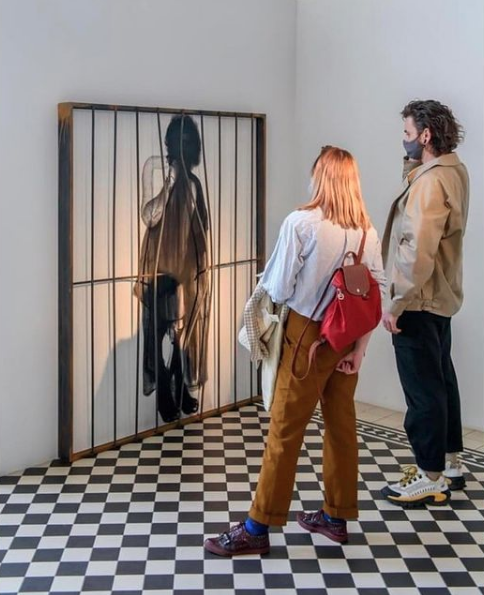Krzysztof Gil
Krzysztof Gil (b. 1987, Kraków) is of Polish Roma origins and grew up in Nowy Targ, Poland. Between 2008-2013, he studied Graphic Design at the Academy of Fine Arts in Krakow. He is the recipient of the Jolanta Kwaśniewska Foundation scholarship ‘Understanding without Barriers’, and a three-time recipient of the Polish Minister of Interior and Administration scholarship.

In 2008, he co-founded the artistic group Romani Art, and is also involved in social activities that oppose discrimination and social exclusion. He is a member of the ternYpe International Roma Youth Network, which helps young Roma people to become active citizens. As he says: ‘From the beginning of my artistic education at high school in Krakow, the topic of Roma has been extremely important to me. Now, years later, I realised that I had to look at my culture from different perspectives and take more distance. It helped me to get involved in projects against intolerance and stereotypes.’

„W koło Macieju smutek tropików”
In 2013, Gil began his PhD at the Academy of Fine Arts in Krakow. His topic is the correlation between the past, present and future of the Roma people, as represented by the Roma word ‘tajsa’, which translates as both ‘today’ and ‘tomorrow.
The story of Romas is a history reflected in the consciousness of non-Romas, in which the Romas themselves rarely speak with their own voice. It is written by the non-Romas in the city chronicles, court files, laws or edicts, traveler relations, etc. That is why Romas are more a subject, a category, rather than the subject of this story. Have this in mind, when learning the story of Romas
Andrzej Mirga and Lech Mróz: Romas, dissimilarity and intolerance
Asking myself how I would like to talk about the Roma culture, I had to decide what stance I would assume in relation to it. Entering the role of a researcher, ethnographer, I would have to become an observer situated outside of this culture. In a sense, it could be a barrier to its artistic interpretation. My two-cultural identity – Polish and Romani, allowed me to analyze the subject I had undertaken, being at the same time in the middle of the Roma culture as well as outside of it. Inspired by the image of colorful folklore, I could create a peculiar artistic expression with rich and diverse customs. I would discuss the still relatively unknown culture, but I would only satisfy the curiosity of the audience. But would I then discover something important for myself?
I had to return to the place that, for me, was the only known source of truth about the Roma – to my grandmother’s house in the Topolowa housing estate in Nowy Targ, where I lived as a child surrounded by family and friends. It was a housing estate with many untrue labels attached, mainly because it was inhabited by a large Romani community. In the seventies, the Roma people were moved by the authorities of that time from the outskirts of the city, from the Kowaniec district, which for centuries had dealt with blacksmithing. Until the end of the 1970s, they owned their own blacksmith’s cooperative, which together with their resettlement to the city center ceased to exist.
Grandma’s kitchen was a place where I heard stories about the times when the family was still living on the outskirts of cities. Their homes were then located near forests. These stories have largely shaped my understanding of Romani. This understanding does not include any colorful camps, because the mountain Roma – Bergitka Roma, from where I come, settled in Podhale in the fifteenth century. For this reason, when I think about the Roma, those from the stories of my grandparents, I do not have in mind Roma women in colorful skirts, singers, musicians dancing before my eyes, I also do not see any outlaws. Although there were musicians there, and quite good ones (my uncles were great violinists, my grandfather could play the accordion), but most of the community performed the hardest work they did not want to take up.
The image, recalled from the memories of my grandparents, is far from the romantic vision determined by those who assumed the name of Bohemia. Roma and the ethos of freedom … nothing more wrong. For they have been enslaved by fear for centuries. This is perfectly evident in the family memories recalled. And it is not about fear that paralyzes, causes dread, but rather about another a kind of fear that is constantly present, it is so natural that it ceases to be perceived. In this way, the stories I cite do not have an autotherapeutic character, the way in which I was brought up prepared me for the consequences of my Roma origins.
I withdrew from recollecting the memories of my grandparents who refers to the times of World War II, choosing those which are outside of its influences. In the annex attached to the thesis, I have put transcripts of the recording of my grandmother’s memories, a record of my experiences from the neo-Nazi assault on the housing estate in which I was raised, and visual material depicting devastated banners of the social campaign in which I took part. Presenting material of a personal nature in this work, I wanted to make it clear to the recipient that the experience of discrimination does not only concern groups of Roma living in extremely difficult conditions, objectionable to the authorities and local reluctance. I trust that the recipient of the stories I am quoting will find universal content in them, and not memories telling of culture foreign to him. At this point, I would like to recall the practice of empowerment, which lay at the ground of the idea of this thesis. The aim of these activities is to achieve a state in which people regain control over their own lives, places, postulates, space, language, etc. They have a sense of agency, influence on reality.
